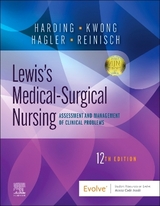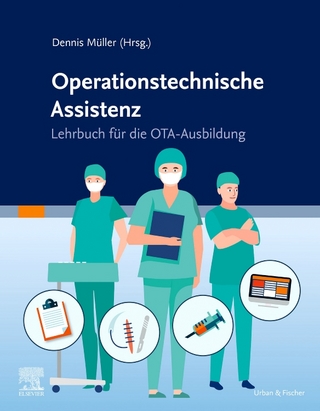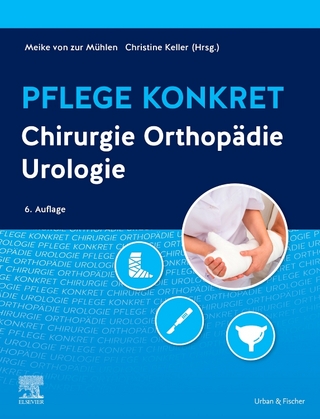
Lewis's Medical-Surgical Nursing
Mosby (Verlag)
978-0-323-67701-1 (ISBN)
- Titel erscheint in neuer Auflage
- Artikel merken
Lewis's Medical-Surgical Nursing, 11th Edition gives you a solid foundation in medical-surgical nursing. This thoroughly revised text includes an increased focus on nursing concepts, strong evidence-based content, coverage of clinical trends, and an essential pathophysiology review. Content is presented in a readable format and covers every unique approach to nursing care including health promotion, acute intervention, and ambulatory care. A variety of helpful boxes and tables make it easy for you to find essential information and a building-block approach throughout make even the most complex concepts simple to grasp. Key topics such as interprofessional care, delegation, safety, and prioritization are integrated throughout. Additionally, extensive drug therapy information and diagnostic studies tables help give you a full picture of care. Best of all - a complete collection of learning and study resources helps you learn more effectively and offers valuable, real-world preparation for clinical practice.
Highly readable format offers students a strong foundation in medical-surgical nursing.
Content written and reviewed by leading experts in the field ensures that information is comprehensive, current, and clinically accurate.
Interprofessional Care tables and sections in all management chapters emphasize the importance of total patient care in today's health care settings and outline the role of each provider in managing disorders.
Bridge to NCLEX Examination review questions at the end of each chapter reinforce key content while helping you to prepare for the NCLEX examination with both standard and alternate item format questions.
Check Your Practice boxes challenge you to think critically and interact with patient data. Scenarios and in-class activity questions are provided to promote active learning.
Informatics in Practice boxes discuss how technology is used by nurses and patients in healthcare settings.
Evidence-based practice boxes help you understand how to apply the latest research to real-life patient care.
Safety Alerts throughout the book highlight patient safety issues and focus on the latest National Patient Safety Goals.
UNIQUE! Nursing management?is presented in a consistent and comprehensive format, addressing the unique approaches to nursing care.
Case Studies throughout text emphasize prioritization, delegation, and concept mapping to help you learn to prioritize and delegate patient care
Separate chapter on Genetics focuses on practical application to nursing care of patients.
Genetics in Clinical Practice boxes cover key topics such as genetic testing, Alzheimer's disease, sickle cell disease, and genetics-related ethics issues.
Genetic Risk alerts and Genetic Link headings highlight specific genetic issues related to body system assessments and disorders.
Ethical/Legal Dilemmas boxes promote critical thinking for timely and sensitive ethical and legal issues.
Pathophysiology Map flow charts make it easier for you to visualize and understand changes occurring in major diseases.
Focused Assessment tables reflect a realistic "assessment on the run" approach and offer brief checklists for evaluating the status of previously identified health problems and monitoring for signs of new problems.
Extensive drug therapy?content includes Drug Therapy tables and concise Drug Alerts highlighting important safety considerations for key drugs.
Promoting Population Health tables summarize government health care goals as they relate to specific disorders and identify important strategies for the prevention and early detection of diseases.
Nutritional Therapy tables summarize nutritional interventions and strategies for promoting healthy lifestyles in patients with various conditions.
Promoting Health Equity boxes and a dedicated chapter on health disparities and culturally competent care highlight risk factors and important issues related to the nursing care of various ethnic groups.
Complementary and Alternative Therapies boxes summarize what you need to know about the clinical uses, effects, and nursing implications of herbal remedies and complementary and alternative treatment options.
Nursing interventions and nursing diagnoses are listed in order of priority
Nursing Management boxes highlight the nurse's role in working with members of the interprofessional team and also cover specific topics and skills related to delegation.
Assessment Abnormalities tables?alert the nurse to frequently encountered abnormalities and their possible etiologies.
Core clinical content focuses on highlighting and incorporating QSEN competencies.
Emergency Management tables outline the treatment of health problems most likely to create medical emergencies.
Learning Outcomes and Key Terms help you identify the key content for that chapter.
Health History tables present key questions to ask patients related to a specific disease or disorder.
Patient and Caregiver teaching tables provide critical information to help you educate others who will be helping to care for the patient.
Gerontology and chronic illness included throughout?the text under Gerontologic Considerations headings and in Gerontologic Assessment tables.
Nursing Assessment tables summarize the key subjective and objective data related to common diseases.
Gender Differences boxes discuss how women and men are affected differently by conditions such as pain and hypertension.
Diagnostic Studies tables provide details of commonly used lab tests that help assess various body systems.
Over 60 nursing care plans clearly shows the linkages among NIC, NOC, and nursing diagnoses, and applies them to nursing practice.
Over 800 full-color illustrations and photographs clearly demonstrate disease processes and related anatomy and physiology.
NEW! An increased focus on concepts throughout the text includes a new Concepts Table of Contents that lists the most common exemplars with page number references, a new Problems Related to Comfort and Coping section, and the most relevant concepts listed at the start of each chapter.
NEW! Additional body map images added throughout text.
Mariann M. Harding, PhD, RN, CNE
Section One - Concepts in Nursing Practice
1. Professional Nursing
2. Health Equity and Culturally Competent Care
3. Health History and Physical Examination
4. Patient and Caregiver Teaching
5. Chronic Illness and Older Adults
Section Two - Problems Related to Comfort and Coping
6. Stress Management
7. Sleep and Sleep Disorders
8. Pain
9. Palliative and End-of-Life Care
10. Substance Use Disorders
Section Three - Problems Related to Homeostasis and Protection
11. Inflammation and Healing
12. Genetics
13. Immune Responses and Transplantation
14. Infection
15. Cancer
16. Fluid, Electrolyte, and Acid-Base Imbalances
Section Four - Perioperative Care
17. Management: Preoperative Care
18. Management: Intraoperative Care
19. Management: Postoperative Care
Section Five - Problems Related to Altered Sensory Input
20. Assessment and Management: Visual Problems
21. Assessment and Management: Auditory Problems
22. Assessment: Integumentary System
23. Management: Integumentary Problems
24. Management: Burns
Section Six - Problems of Oxygenation: Ventilation
25. Assessment: Respiratory System
26. Management: Upper Respiratory Problems
27. Management: Lower Respiratory Problems
28. Management: Obstructive Pulmonary Diseases
Section Seven - Problems of Oxygenation: Transport
29. Assessment: Hematologic System
30. Management: Hematologic Problems
Section Eight - Problems of Oxygenation: Perfusion
31. Assessment: Cardiovascular System
32. Management: Hypertension
33. Management: Coronary Artery Disease and Acute Coronary Syndrome
34. Management: Heart Failure
35. Management: Dysrhythmias
36. Management: Inflammatory and Structural Heart Disorders
37. Management: Vascular Disorders
Section Nine - Problems of Ingestion, Digestion, Absorption, and Elimination
38. Assessment: Gastrointestinal System
39. Management: Nutritional Problems
40. Management: Obesity
41. Management: Upper Gastrointestinal Problems
42. Management: Lower Gastrointestinal Problems
43. Management: Liver, Biliary Tract, Pancreas
Section Ten - Problems of Urinary Function
44. Assessment: Urinary System
45. Management: Renal and Urologic Problems
46. Management: Acute Renal Failure and Chronic Kidney Disease
Section Eleven - Problems Related to Regulatory and Reproductive Mechanisms
47. Assessment: Endocrine System
48. Management: Diabetes Mellitus
49. Management: Endocrine Problems
50. Assessment: Reproductive System
51. Management: Breast Disorders
52. Management: Sexually Transmitted Infections
53. Management: Female Reproductive Problems
54. Management: Male Reproductive Problems
Section Twelve - Problems Related to Movement and Coordination
55. Assessment: Nervous System
56. Management: Acute Intracranial Problems
57. Management: Stroke
58. Management: Chronic Neurologic Problems
59. Management: Alzheimer's Disease and Dementia
60. Management: Peripheral Nerve and Spinal Cord Problems
61. Assessment: Musculoskeletal System
62. Management: Musculoskeletal Trauma and Orthopedic Surgery
63. Management: Musculoskeletal Problems
64. Management: Arthritis and Connective Tissue Diseases
Section Thirteen - Nursing Care in Specialized Settings
65. Management: Critical Care
66. Management: Shock, Systemic Inflammatory Response Syndrome, and Multiple Organ Dysfunction Syndrome
67. Management: Respiratory Failure and Acute Respiratory Distress Syndrome
68. Management: Emergency Care Situations
Appendixes
A: Basic Life Support for Health Care Providers
B: Nursing Diagnosis
C: Laboratory Reference Intervals
Glossary
Index
| Erscheinungsdatum | 07.11.2019 |
|---|---|
| Verlagsort | St Louis |
| Sprache | englisch |
| Gewicht | 3260 g |
| Themenwelt | Pflege ► Fachpflege ► Chirurgie / OP-Pflege / Orthopädie |
| ISBN-10 | 0-323-67701-0 / 0323677010 |
| ISBN-13 | 978-0-323-67701-1 / 9780323677011 |
| Zustand | Neuware |
| Haben Sie eine Frage zum Produkt? |
aus dem Bereich



